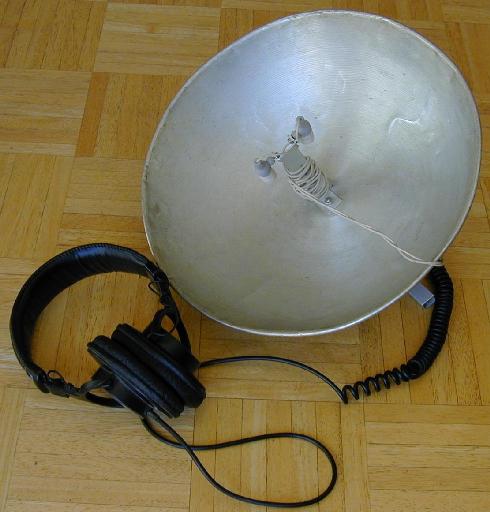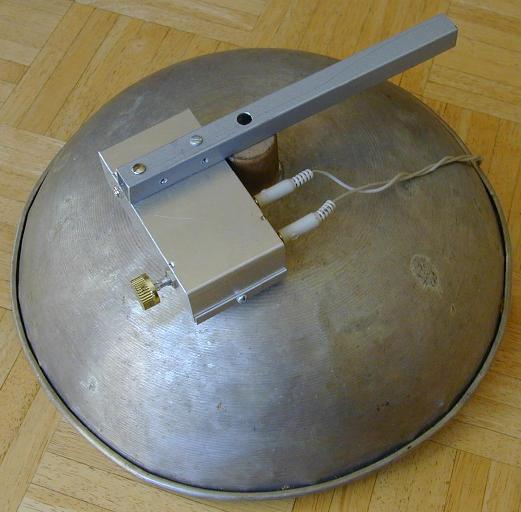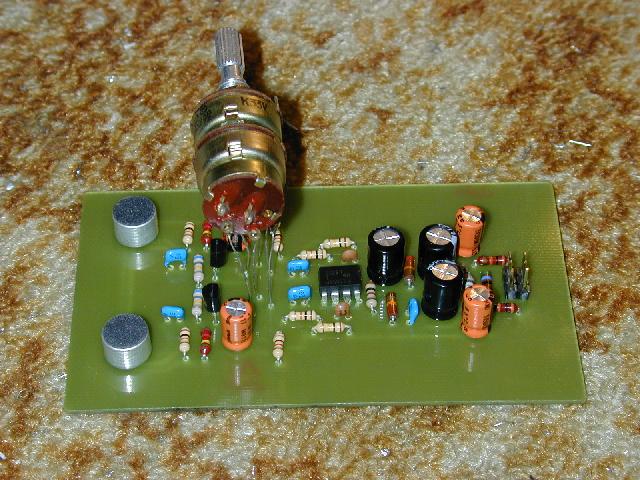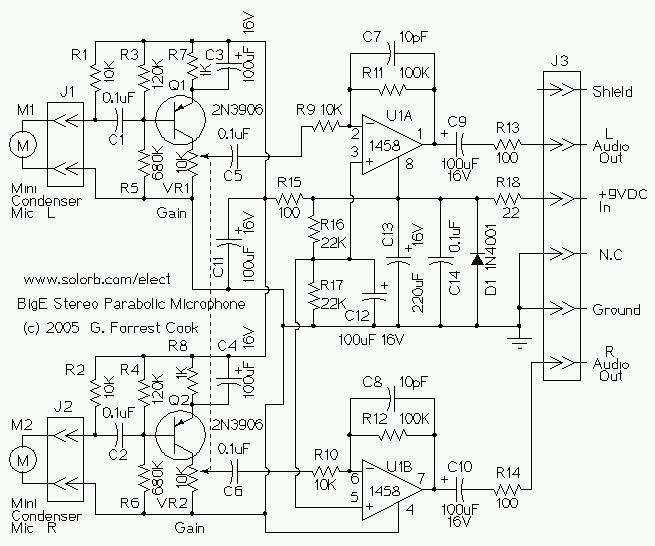

Front view of the Big-E

Rear view of the Big-E

This surveillance version of the circuit has microphones on board.

(C) G. Forrest Cook January 1, 2005
This device is a high sensitivity stereo parabolic microphone. It can be used for listening to distant sounds. Most parabolic microphones are monophonic, this unit has a stereo audio path that helps produce more realistic sounding audio. The Big-E can be used with headphones or as an audio source for a stereo recorder. It can be plugged directly into a computer sound card's aux input.
This circuit also works nicely as a remote stereo audio amplifier that can be used in conjunction with a video surveillance system. It can be operated on the end of a four wire shielded cable that is up to several hundred feet long. For remote operation, a set of amplified PC speakers can be connected to the outputs to monitor the sound.
Operating Voltage: 9-15V (9V Nominal) DC Operating Current: 7ma at 9V DC
The circuit consists of two identical audio channels and some basic power supply filtering components. Only one channel will be described.
The mini condenser microphone converts sounds into an electrical signal. Resistor R1 provides bias for the condensor microphone's internal amplifier transistor. The value of R1 can be adjusted to get the most gain from your particular microphones, useful values range from around 1K to 20K.
The 2N3906 PNP transistor is configured as a low-noise class A microphone input amplifier. The 10K gain potentiometer is used for adjusting the audio signal level. A stereo 10K audio taper pot can be used for adjusting both channels simultaneously, or individual 10K trimmers can be used for fixed-gain applications.
The preamp output signal is fed into the 1458 op-amp, which boosts the audio to a level that is sufficient for driving a headphone or a tape recorder input. The 1458 amplifier stage is wired as a fixed-gain (10X) inverting amp.
Capacitor C9 provides DC isolation from the 1458 op-amp output, which sits at half of the supply voltage. Resistor R13 provides impedance protection for the op-amp output and reduces audio distortion when driving low impedance headphones.
The DC bias for the 1458 op-amps is set at half of the supply voltage by the R16/R17 voltage divider. Capacitors C13 and C14 filter the DC power supply for the op-amp stage. The DC is further filtered for the input preamp transistors through resistor R15 and capacitor C11. Diode D1 and resistor R18 protect the circuit from reverse battery polarity.
The Big-E circuit can be assembled on a circuit board or hand wired in a point-to-point fashion. The board can be installed in a metal box for shielding from unwanted hum. The condenser microphones can be mounted directly on the PC board, as shown in the bottom photo. The microphones can also be connected to the board via two 3.5MM mono jacks, as shown in the middle photo.
The volume control can be mounted on the side of the metal box. A 3.5MM stereo jack was used for the headphone output, it was mounted on the side of the metal box. The 9V battery was mounted inside of the box, power is switched via a switch on the 10K stereo potentiometer.
The parabolic microphone assembly is made from a 13" Chinese wok cooker lid. The microphones are mounted on a metal standoff that places them at the focal point of the parabolic reflector. Pre-formed computer microphones were used for the model shown, any electret condenser microphones should work.
The optimal microphone position can be found by pointing the reflector at a distant audio source, then moving the microphones for the loudest sound. The amplifier box was mounted on the back side of the wok lid, it was attached to a piece of 1/2" square aluminum tubing, which forms a handle.
Start with the volume turned down, point the Big-E at a remote sound source, then gradually turn the volume up until the sound is heard. Be careful not to bang the side of the parabolic dish when listening, loud sounds can result. Also, beware that a malicious friend can cause you pain in the ears by sneaking up and talking into the parabolic mic. It is advisable to wear the headphones partially off of your ears while you get used to the operation of the device.
The Big-E is great for listening to birds and distant thunderstorms. It is also possible to hear the rustling of leaves on the top of a distant tree during a breezy day. Close-in wind noise may overpower distant sounds, operate the Big-E from a wind-sheltered area if possible.
Back to FC's Electronic Circuits page.